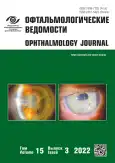Сases of lacrimal system affection after Coronavirus infection
- 作者: Beldovskaya N.Y.1, Anikina L.K.1, Angelopoulo G.V.1, Moroziuk A.1
-
隶属关系:
- Academician I.P. Pavlov First St. Petersburg State Medical University
- 期: 卷 15, 编号 3 (2022)
- 页面: 91-100
- 栏目: Case reports
- URL: https://journals.rcsi.science/ov/article/view/131580
- DOI: https://doi.org/10.17816/OV111169
- ID: 131580
如何引用文章
详细
In the present article, cases of lacrimal apparatus conditions emerging after a new Coronavirus infection COVID-19. The aim of the study is to determine the causes of epiphora in patients after Coronavirus infection.
26 patients (30 eyes) were examined, aged from 28 to 70 years, complaining of tearing, which emerged for the first time ever not earlier than 5–14 days from the onset of the laboratory-confirmed Coronavirus infection COVID-19, which had a mild or a moderately severe course and was accompanied by anosmia.
In patients, following conditions of the lacrimal system were revealed: in 22 patients, there were pathological changes of the horizontal portion of lacrimal pathways; in 6 people dry eye syndrome was diagnosed: in 3 people, it was of mild severity, manifested by hyperlacrimia, 3 people had moderate severity of the dry eye syndrome. As concomitant, following signs were revealed: in 7 patients — rhinologic conditions were present, in 2 people — neurologic signs.
In the examined group of patients with epiphora, we found that in 1.5–3 month after Coronavirus infection COVID-19 with anosmia, as a common sign of the disease in more than a half of cases, a development of pathological changes of the horizontal portion of lacrimal pathways was revealed.
作者简介
Nataliya Beldovskaya
Academician I.P. Pavlov First St. Petersburg State Medical University
Email: beldovskay@mail.ru
ORCID iD: 0000-0001-9864-504X
SPIN 代码: 8331-1449
MD, Cand. Sci. (Med.), Associate Professor, Yu.S. Astakhov Department of Ophthalmology with Clinic
俄罗斯联邦, Saint PetersburgLiliia Anikina
Academician I.P. Pavlov First St. Petersburg State Medical University
编辑信件的主要联系方式.
Email: lily-sai@yandex.ru
ORCID iD: 0000-0001-8794-0457
SPIN 代码: 3359-4587
Postgraduate Student
俄罗斯联邦, Saint PetersburgGalina Angelopoulo
Academician I.P. Pavlov First St. Petersburg State Medical University
Email: nmaculova@yandex.ru
MD, Cand. Sci. (Med.), Associate Professor, Yu.S. Astakhov Department of Ophthalmology with Clinic
俄罗斯联邦, Saint PetersburgAnna Moroziuk
Academician I.P. Pavlov First St. Petersburg State Medical University
Email: ana.moroziuk@gmail.com
ORCID iD: 0000-0002-2082-3341
SPIN 代码: 7506-6597
Postgraduate Student, Yu.S. Astakhov Department of Ophthalmology with Clinic
俄罗斯联邦, Saint Petersburg参考
- Yaguchi S, Ogawa Y, Shimmura S, et al. Presence and physiologic function of the renin-angiotensin system in mouse lacrimal gland. Invest Ophthalmol Vis Sci. 2012;53(9):5416–5425. doi: 10.1167/iovs.12-9891
- Giese MJ, Speth RC. The ocular renin-angiotensin system: a therapeutic target for the treatment of ocular disease. Pharmacol Ther. 2014;142(1):11–32. doi: 10.1016/j.pharmthera.2013.11.002
- Vaajanen A, Kalesnykas G, Vapaatalo H, Uusitalo H. The expression of Mas-receptor of the renin-angiotensin system in the human eye. Graefes Arch Clin Exp Ophthalmol. 2015;253(7):1053–1059. doi: 10.1007/s00417-015-2952-z
- Turgel VA, Antonov VA, Tultseva SN, et al. COVID-19 as a new risk factor for the development of acute vascular diseases of the optic nerve and retina. Ophthalmology Journal. 2021;14(2):105–115. (In Russ.) doi: 10.17816/OV64115
- www.who.int [Internet]. Osnovnye svedeniya o COVID-19. Available at: https://www.who.int/ru/news-room/questions-and-answers/item/coronaviruse-disease-covid-19 (In Russ.)
- Brzheskiy VV, Konikova OA, Sadovnikova NN, Efimova EL. Changes in the organ of vision in children and adults with confirmed COVID-19 and anti-epidemic measures. Russian ophthalmology of children. 2021;(3):44–53. (In Russ.) doi: 10.25276/2307-6658-2021-3-44-53
- Chen L, Liu M, Zhang Z, et al. Ocular manifestations of a hospitalised patient with confirmed 2019 novel coronavirus disease. Br J Ophthalmol. 2020;104(6):748–751. doi: 10.1136/bjophthalmol-2020-316304
- Khavandi S, Tabibzadeh E, Naderan M, Shoar S. Corona virus disease-19 (COVID-19) presenting as conjunctivitis: atypically high-risk during a pandemic. Cont Lens Anterior Eye. 2020;43(3):211–212. doi: 10.1016/j.clae.2020.04.010
- Trufanov SV, Malozhen SA, Krakhmaleva DA, et al. Antiangiogenic therapy in high-risk keratoplasty. Vestnik Oftalmologii. 2020;136(4):1118. (In Russ). doi: 10.17116/oftalma202013604111
- Meduri A, Oliverio GW, Mancuso G, et al. Ocular surface manifestation of COVID-19 and tear film analysis. Sci Rep. 2020;10(1):20178. doi: 10.1038/s41598-020-77194-9
- Cheema M, Aghazadeh H, Nazarali S, et al. Keratoconjunctivitis as the initial medical presentation of the novel coronavirus disease 2019 (COVID-19). Can J Ophthalmol. 2020;55(4):e125–129. doi: 10.1016/j.jcjo.2020.03.003
- Guo D, Xia J, Wang Y, et al. Relapsing viral keratoconjunctivitis in COVID-19: A case report. Virol J. 2020;17:97. doi: 10.1186/s12985-020-01370-6
- Lan QQ, Zeng SM, Liao X. A special on epidemic prevention and control: screening for novel coronavirus related conjunctivitis among the patients with coronavirus disease 2019. Zhonghua Yan Ke Za Zhi. 2020;56(6):433–437. [In Chinese]. doi: 10.3760/cma.j.cn112142-20200322-00213
- Martínez Díaz M, Copete Piqueras S, Blanco Marchite C, Vahdani K. Acute dacryoadenitis in a patient with SARS-CoV-2 infection. Orbit. 2021;41(3):374–377. doi: 10.1080/01676830.2020.1867193
- Sen M, Honavar SG, Sharma N, Sachdev MS. COVID-19 and Eye: A Review of Ophthalmic Manifestations of COVID-19. Indian J Ophthalmol. 2021;69(3):488–509. doi: 10.4103/ijo.IJO_297_21
- Neroev VV, Krichevskaya GI, Balatskaya NV. COVID-19 and problems of ophthalmology. Russian Ophthalmological Journal. 2020; 13(4):99–104. (In Russ.) doi: 10.21516/2072-0076-2020-13-4-99-104
- Al-Namaeh M. COVID-19 and conjunctivitis: a meta-analysis. Ther Adv Ophthalmol. 2021;13:25158414211003368. doi: 10.1177/25158414211003368
- Brzheskii VV, Somov EE. Sindrom sukhogo glaza. Saint Petersburg: Apollon, 1998. 96 p. (In Russ.)
- Hu Y, Chen T, Liu M, et al. Positive detection of SARS-CoV-2 combined HSV1 and HHV6B virus nucleic acid in tear and conjunctival secretions of a non-conjunctivitis COVID-19 patient with obstruction of common lacrimal duct. Acta Ophthalmol. 2020;98(8):859–863. doi: 10.1111/aos.14456
补充文件













